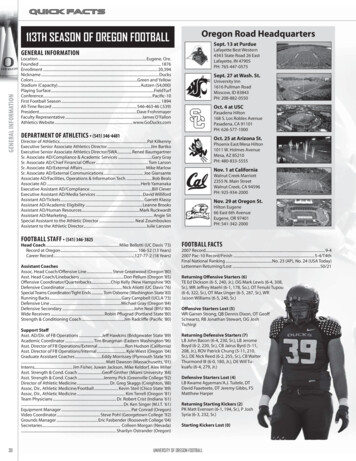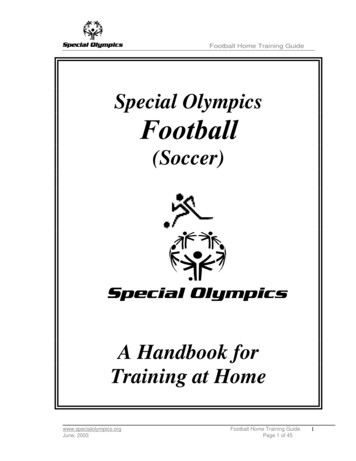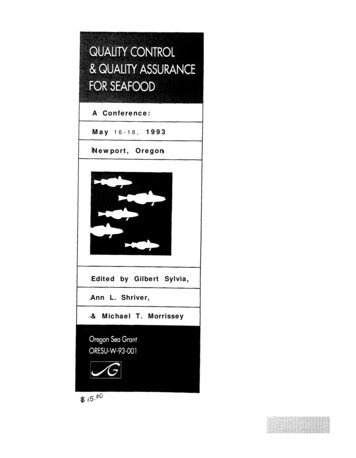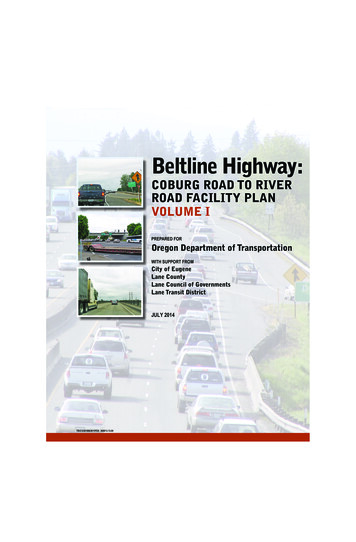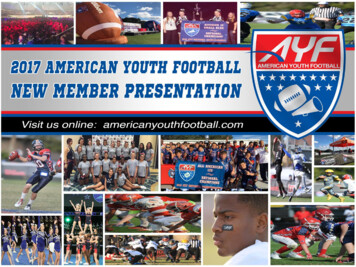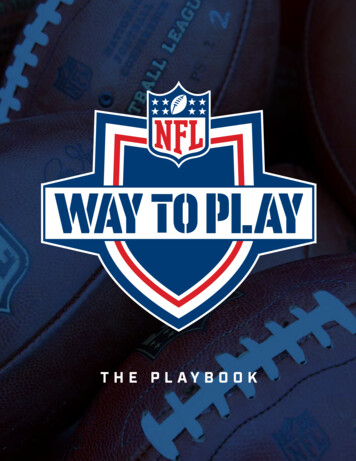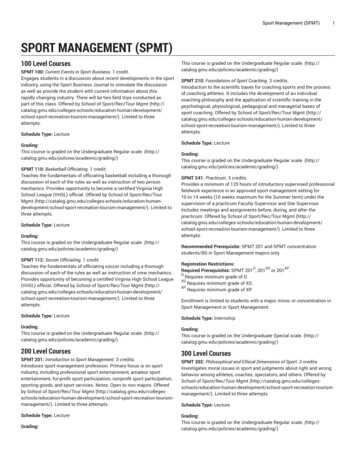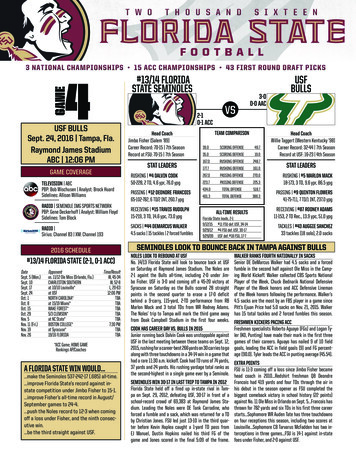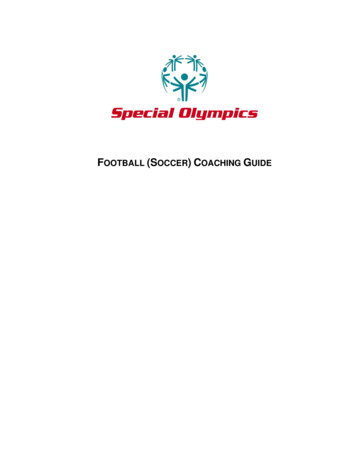
Transcription
Oregon School Activities Association25200 SW Parkway Avenue, Suite 1Wilsonville, OR 97070503.682.6722http://www.osaa.org2022 FOOTBALL PLAN BOOKStaff Contact: Kris Welch, Assistant Executive Director, 503.682.6722 x230, krisw@osaa.orgSEASON DATESFirst Practice Date . August 15First Jamboree Date . August 25First Contest Date . September 16A, 5A, 1A (8) Rankings Freeze Date . 10pm, October 296A, 5A, 1A (8) Cutoff Date . October 294A, 3A, 2A (9), 1A (6) Rankings Freeze Date . 10pm, October 294A, 3A, 2A (9) , 1A (6) Cutoff Date . October 29All Sub‐Varsity Cutoff . October 31All Classifications First Round . November 4‐51A (6) Semifinals . November 11‐126A, 5A, 4A, 3A, 2A (9), 1A (8) Quarterfinals . November 11‐121A (6) State Championship . November 18‐196A, 5A, 4A, 3A, 2A (9), 1A (8) Semifinals . November 18‐196A, 5A, 4A, 3A, 2A (9), 1A (8) State Championships. November 25‐26Reporting Schedules and Scores – Find Account Instructions on our Help Page at http://www.osaa.org/helpNFHS 2022 FOOTBALL RULESOrder a NFHS Football Rules Book from the OSAA Corner Store or contact the OSAA (503.682.6722) for more information.For more information about NFHS Football Rules, visit 2022 RULES CHANGES1‐2‐3g NOTES 3. (NEW)Team Box May Be Extended By State Association Adoption. By state association adoption, theteam box may now be extended beyond the 25‐yard line.1‐3‐3Ball May Be Changed Between Downs. Any game official may order the ball changed between downs.1‐4‐3The Number “0” Is Now Legal. The single digit number “0” is now a legal number.2‐3‐8A Chop Block Has Been Redefined. A chop block has been redefined as an illegal combinationblock where contact is made above and below the waist.3‐4‐7Clarified The Offended Team’s Game Clock Options. Clarified the offended team’s game clockoptions following a foul committed with less than two minutes remaining in either half.3‐6‐1a(1)e EXCEPTION 2. (NEW) Added A New Exception To The Play Clock Administration. Added a new exception to the playclock administration following a foul committed only by the defensive team.7‐5‐2 EXCEPTION 2. (NEW)Added A New Exception For The Passer. Added a new exception that allows the passer to legallythrow the ball away to conserve lan.docxPage 1 of 38
2022 EDITORIAL CHANGES2‐28‐2; 5‐2‐4; 6‐2‐6; 10‐2‐2; 10‐2‐3; FOOTBALL FUNDAMENTALS – VII‐2, X‐3‐E; RESOLVING TIED GAMES – 5‐1‐1, 8‐3; NINE‐, EIGHT‐AND SIX‐PLAYER RULES DIFFERENCES – RULE 2 and 72022 POINTS OF EMPHASIS1.Targeting / Defenseless Player2.Legal Uniforms and Equipment3.Sportsmanship2022 JERSEY & PANT RULES (March 2022)RULE 1‐4‐3ART. 3 . . . Each player shall be numbered 0 through 99 inclusive.RULE 1‐5‐1ART. 1 . . . Mandatory Equipment. Each player shall participate while wearing the following pieces of properly fitted equipment,which shall be professionally manufactured and not altered to decrease protection:b.Jersey:1. A jersey, unaltered from the manufacturer’s original design/production, and which shall be long enough to reach the top ofthe pants and shall be tucked in if longer. It must completely cover the shoulder pads and all pads worn above the waist onthe torso.2. Players of the visiting team shall wear jerseys, unaltered from the manufacturer’s original design/production, that meet thefollowing criteria: The body of the jersey (inside the shoulders, inclusive of the yoke of the jersey or the shoulders, below thecollar, and to the bottom of the jersey) shall be white and shall contain only the listed allowable adornments and accessorypatterns in a color(s) that contrasts to white:(a) as the jersey number(s) required in 1‐5‐1c or as the school’s nickname, school logo, school name and/or playername within the body and/or on the shoulders,(b) either as a decorative stripe placed during production that follows the curve of the raglan sleeve or following theshoulder seam in traditional yoke construction, not to exceed 1 inch at any point within the body of the jersey; or asdecorative stripe(s) added in the shoulder area after production, not to exceed 1 inch per stripe and total size ofcombined stripes not to exceed 3.5 inches,(c) within the collar, a maximum of 1 inch in width, and/or(d) as a side seam (insert connecting the back of the jersey to the front), a maximum of 4 inches in width but any non‐whitecolor may not appear within the body of the jersey (inside the shoulders, inclusive of the yoke of the jersey or theshoulders, below the collar, and to the bottom of the jersey). The exception to (d) would be what is stated in (b) above.(e) The visiting team is responsible for avoidance of similarity of colors, but if there is doubt, the referee may require playersof the home team to change jerseys.NOTE: One American flag, not to exceed 2 inches by 3 inches, may be worn or occupy space on each item of uniform apparel. By stateassociation adoption, to allow for special occasions, commemorative or memorial patches, not to exceed 4 square inches, may beworn on the uniform without compromising its integrity.3. Players of the home team shall wear jerseys, unaltered from the manufacturer’s original design/production, that meet thefollowing criteria: The body of the jersey (inside the shoulders, inclusive of the yoke of the jersey or the shoulders, below thecollar, and to the bottom of the jersey) may not include white, except as stated below. The jerseys of the home team shall bea dark color that clearly contrasts to white. If white appears in the body of the jersey of the home team, it may only appear:(a) as the jersey number(s) required in 1‐5‐1c or as the school’s nickname, school logo, school name and/or playername within the body and/or on the shoulders,(b) either as a decorative stripe placed during production that follows the curve of the raglan sleeve or following theshoulder seam in traditional yoke construction, not to exceed 1 inch at any point within the body of the jersey; or asdecorative stripe(s) added in the shoulder area after production, not to exceed 1 inch per stripe and total size ofcombined stripes not to exceed 3.5 inches,(c) within the collar, a maximum of 1 inch in width, and/or(d) as a side seam (insert connecting the back of the jersey to the front), a maximum of 4 inches in width but any .docxPage 2 of 38
color may not appear within the body of the jersey (inside the shoulders, inclusive of the yoke of the jersey or theshoulders, below the collar, and to the bottom of the jersey). The exception to (d) would be what is stated in (b) above.(e) The visiting team is responsible for avoidance of similarity of colors, but if there is doubt, the referee may require playersof the home team to change jerseys.NOTE: One American flag, not to exceed 2 inches by 3 inches, may be worn or occupy space on each item of uniform apparel. By stateassociation adoption, to allow for special occasions, commemorative or memorial patches, not to exceed 4 square inches, may beworn on the uniform without compromising its integrity.c. Numbers:1. The numbers shall be clearly visible and legible using Arabic numbers 1‐99 inclusive and shall be on the front and back of thejersey.2. The numbers, inclusive of any border(s), shall be centered horizontally at least 8 inches and 10 inches high on front andback, respectively.3. The entire body of the number (the continuous horizontal bars and vertical strokes) exclusive of any border(s) shall beapproximately 1½‐inches wide.4. The color and style of the number shall be the same on the front and back.5. Through the 2023 season, the body of the number (the continuous horizontal bars and vertical strokes) shall be either:(a) a continuous color(s) contrasting with the jersey color; or(b) the same solid color(s) as the jersey with a minimum of one border that is at least ¼‐inch in width of a single solidcontrasting color.6. Effective with the 2024 season, the entire body of the number (the continuous horizontal bars and vertical strokes) shallbe a single solid color that clearly contrasts with the body color of the jersey.d. Pads and Protective Equipment – The following pads and protective equipment are required of all players:1. Hip pads and tailbone protector which are unaltered from the manufacturer’s original design/production.2. Knee pads which are unaltered from the manufacturer’s original design/production, which are worn over the knee and underthe pants and shall be at least ½ inch thick or 3/8 inch thick if made of shock absorbing material.3. Shoulder pads and hard surface auxiliary attachments, which shall be fully covered by a jersey.4. Thigh guards which are unaltered from the manufacturer’s original design/production.e.Pants ‐ which completely cover the knees, thigh guards and knee pads and any portion of any knee brace that does not extendbelow the pants.RULE 1‐5‐3ART. 3 . . . Illegal Equipment. No player shall participate while wearing illegal equipment. This applies to any equipment, which inthe opinion of the umpire is dangerous, confusing or inappropriate. Illegal equipment shall always include but is not limited to:a. The following items related to the Game Uniform:1. Jerseys and pants that have:(a) A visible logo/trademark or reference exceeding 2¼ square inches and exceeding 2¼ inches in any dimension.(b) More than one manufacturer’s logo/trademark or reference on the outside of either item. (The same sizerestriction shall apply to either the manufacturer’s logo/trademark or reference).(c) Sizing, garment care or other non logo labels on the outside of either item.3. Tear‐away jerseys or jerseys that have been altered in any manner that produces a knot‐like protrusion orcreates a tear‐away jersey.4. Any transverse stripe on the sleeve below the elbow.c. The following items related to Other Illegal Equipment:1. Ball‐colored helmets, jerseys, patches, exterior arm covers/pads, undershirts or gloves.5. Jerseys, undershirts or exterior arm covers/pads manufactured to enhance contact with the football or opponent.9. Equipment not worn as intended by the manufacturer.Requests for rule interpretations or explanations should be directed to the OSAA. The NFHS will assist in answering rules questionsfrom the state associations whenever called .docxPage 3 of 38
OSAA ADOPTED FOOTBALL RULES AND INTERPRETATIONSThe 2022 NFHS Football Rules Book will be used with the following clarifications:1.TIE GAMES – REGULAR SEASONA. The procedure on page 86‐88 of the 2021 NFHS Football Rules Book shall be used to decide all ties in varsity games played inOregon with the exception that the first and second overtime series shall begin on the 25‐yard line; any subsequent overtimeseries shall begin on the 10‐yard line.B. NOTE: It is the option of each athletic district as to whether the tie‐breaking method will be utilized below the varsity level.This option should be communicated to the local officials’ Association.2.FOOTBALL – CLEATS: In addition to the unsportsmanlike conduct penalty (15 yards) specified by the National Federation RulesBook, a student who is wearing illegal cleats in excess of 1/2” in length shall be ejected from the contest, whether or not thestudent has participated.3.FOOTBALL – LEAGUE PLAYOFF PROHIBITION: Leagues shall not use on‐the‐field procedures such as the “Kansas Plan” to break ties inleague football standings at the end of the regular season. Each league shall develop its own standard operating procedure for resolvingleague ties off the field.4.FOOTBALL – VIDEO EXCHANGE: Each school participating in the Football State Championships, excluding schools assigned to the1A classification, shall be required to exchange at least two videos with their next opponent using HUDL. The opposing coacheschoose which videos to receive, and the exchange must be completed by noon on Sunday preceding the game in which the twoschools meet.5.TEAM BOX: The team box will remain between the 25‐yard lines and will NOT be extended.6.ONE VOICE from the BENCH POLICY: The voice shall either be the head coach or their one designee.A. Initial violation shall be penalized under Rule 9‐8‐1a, b, c, or d AND, shall included a warning to the head coach.B. Subsequent violations shall be penalized to both the offending non‐player AND the head coach with only one 15‐yardpenalty enforced.7.WRAP‐UP TACKLE REQUIREMENT: To make the game safer, the wrap‐up tackle will be required when taking down adefenseless player in the4 following situations:A. Rule 2‐32‐16b – Against a receiver attempting to catch a pass who has not had time to clearly become a runner.B. Rule 2‐32‐16c – Against the intended receiver of a pass in the action during and immediately following an interception orpotential interception.C.Rule 2‐32‐16e – Against a kickoff or punt returner attempting to catch or recover a kick, or one who has completed a catchor recovery and has not yet had time to protect himself or has not clearly become a runner.D. No player shall execute forceful contact against a player described in Rule 2‐32‐16h, Rule 2‐32‐16c, or Rule 2‐31‐16e that isnot –1) Incidental contact as a result of making a play on the ball; or2) Initiated with an open hand push; or3) A wrap‐up style tackle or an attempt to tackle the receiver by wrapping the arms around the receiver.E.Any contact other than a wrap‐up tackle shall be interpreted as a violation of UNR 9‐4‐3g and assessed a 15‐yard penalty.OSAA FOOTBALL POLICIESEffective outside Association Year.1.SUMMER POLICY (OSAA Handbook, Executive Board Policies)(Revised Fall 2017)A. All Sports. Summer activities under the direction of any person affiliated with the high school program, including practices,contests, weight training and conditioning, are permissible throughout the summer, excluding the defined Moratorium Week,and must consider the following points:1) OSAA regulations regarding the Heat Index Calculator are in effect at all times. Athletes must be encouraged to stay wellhydrated at all times, especially in hot and humid conditions. This applies to outdoor activities and indoor activitieswithout air conditioning. See the NFHS statements on heat and lplan.docxPage 4 of 38
2)Implement a slow and gradual preseason‐conditioning regimen that prepares the athlete for the rigors of the sport.3) Slowly build up the intensity of activity over several days.4) Have fitness tests (mile run, shuttle run times, maximum repetition exercises) scheduled the second week of practices.Use a progressive, periodized program and evaluate performance once athletes are acclimated to the stress about to beplaced upon them.5) Take into account the level of conditioning of all individuals and what their previous conditioning has been. Athleteswho have just finished a sports season should have at least a short period (one to two weeks) of relative rest.6) Slowly introduce new exercises or workout routines to allow for adaptation by muscle groups.7) Provide adequate rest and recovery between repetitions in the weight room and especially during “gassers” and intensestation or “mat” drills.8) Athletes should refrain from consuming high caffeine energy drinks and supplements, or other stimulants, as they maycontribute to dehydration. See the NFHS statement on energy drinks.9) Athletes should refrain from extreme exercise during acute illness, if feeling ill, or while experiencing a fever.B. Football Only. Member schools are only allowed to utilize protective football equipment for eight days within one 10consecutive day period beginning after the last day of the Association Year and concluding prior to the start of MoratoriumWeek, with the following requirements:1) No protective equipment shall be utilized from the start of Moratorium Week until the first day of the Association Year.2) All levels of a program (Varsity, JV, etc.) shall use the same 10 consecutive day period, including prospective student‐athletes (e.g., incoming freshmen).3) At the beginning of the 10‐consecutive day period, every student shall be required to have two days of helmet onlypractices. During this period, the only optional pieces of protective equipment that may be worn by individuals are shoesand helmets. No other pads (e.g., shoulder, knee, thigh, hip and rib) are to be worn. During helmet only practice, no liveaction drills or any other activity may occur which would result in a player completing a tackle or being blocked or tackledto the ground. This policy does not preclude light contact with blocking sleds and tackling dummies. However, it isstrongly recommended that any such contact be carefully controlled. Helmet only practice sessions are limited to amaximum of three hours in length.4) Following two days of helmet only practices, students may wear helmets and shoulder pads on Day 3. On this day, theonly optional pieces of protective equipment that may be worn by individuals are shoes, shoulder pads and helmets. Noother pads (e.g., knee, thigh, hip and rib) are to be worn. During helmet/shoulder pad practice, no live action drills orany other activity may occur which would result in a player completing a tackle or being blocked or tackled to the ground.This policy does not preclude light contact with blocking sleds and tackling dummies. However, it is stronglyrecommended that any such contact be carefully controlled. Helmet and shoulder pad practice sessions are limited to amaximum of three hours in length.5) After completing the first three days, an individual may use the remainder of the football gear as described in the NFHSFootball Rules Book for a maximum of five days. Activity during this five‐day period is not restricted with regard tocontact as defined by USA Football Levels of Contact.a)Level 3 (Thud) is the maximum level of play if not participating in full protective equipment.b) Level 4 (Live Action) occurs only between players in full protective equipment and shall not exceed more than 30plays per player per day.c)Only one practice session per day during this five‐day period may contain Live Action.d) Additional practice session restrictions:(1) Length of any practice session during this five‐day period shall not exceed 2.5 hours.(2) Minimum recovery time between practice sessions is equivalent to total amount of time spent in previouspractice session.(3) All players are limited to a maximum of five hours per day in protective equipment.(4) Teams may conduct an additional “teaching session” each day during this time period where no protectiveequipment of any type is used. Maximum time length for a teaching session is two hours. During a teachingsession, the intensity, duration and pace of all practice components shall be modified from a normal lan.docxPage 5 of 38
session. The focus of a teaching session should be directed at developing skills fundamental to the sport at asignificantly reduced pace. Light contact with bags is allowed but live action situations are prohibited. Practicecomponents in all activities intended to develop skills while conditioning the athlete at the same time are notallowed. Coaches are encouraged to use this “teaching session” to address offensive and defensive strategies,skill development drills and other types of team building activities that do not involve conditioning.6) A school shall not permit an individual to use the remainder of the football gear as described in the NFHS Football RulesBook unless that individual has had at least two days of helmet only practice and one day of helmet/shoulder padpractice.7) It is imperative that local school administrators set guidelines for participation in the 10‐consecutive day period. Safetyof the participants is of the utmost importance; therefore, proper fundamental and physical preparation is necessaryprior to the participants engaging in any type of person‐to‐person contact.8) Individual school districts and other member schools of the association have the option of determining whether or notthey will allow a school within their district to participate in one 10 consecutive day period that involves the use ofprotective equipment. This decision should take into consideration the inherent liability when a team represents theschool district, is supervised by school personnel, uses school district transportation, uses school facilities, andparticipants use protective equipment owned by the school.9) Individual school districts and other member schools of the association have the option of determining whether or notthey will allow an individual student within their district to use protective equipment owned by the school whenattending camps/clinics not organized by any member school personnel. This decision should take into considerationthe inherent liability when participants use protective equipment owned by the school.10) Prior to participation in one 10‐consecutive day period, each participant should be required to show proof of insuranceand provide documentation of a valid physical examination within the last two years as prescribed by Oregon law.Coaches and other supervisors should have liability insurance.1.Q. Does Part B of the Summer Policy apply to conditioning, technique, or other camps/clinics that do not use protectiveequipment?A. No, schools can continue to conduct/attend these types of activities as long as protective equipment is not worn.2.Q. Can helmets, including soft‐shell helmets, be worn during 7‐on‐7 competitions?A. Yes, as long as the 7‐on‐7 competitions are conducted during the 10‐consecutive day period outlined in the policy.Helmets, including soft‐shell helmets, may not be worn outside the 10‐consecutive day period.3.Q. If an individual(s) has participated in a team camp during which protective equipment was worn, can that individual(s)borrow protective equipment from a school to attend camps/clinics occurring either before or after that point?A. The answer depends on the nature of the preceding or subsequent camp/clinic. Individuals can attend multiple campswhere protective equipment is worn as long as no member of the school’s coaching staff has organized attendance atthe preceding or subsequent camps/clinics and no member of the school’s coaching staff is a member of the precedingor subsequent camps/clinics regardless of the number of attendees from a single school. General dissemination ofinformation does not count as organizing attendance.4.Q. Is the 10‐consecutive day period during which protective equipment can be worn applicable to each level of competitionseparately?A. No, the policy requires that the same 10 consecutive day period be used by all levels (Varsity, JV, Frosh, etc.).5.Q. Can the 10‐consecutive day period during which protective equipment is worn occur after the Moratorium Week hasconcluded?A. No. No protective equipment can be worn for team camp(s)/clinic(s) purposes during the timeframe between theconclusion of Moratorium Week and the start of the OSAA Association year. Protective equipment may be issued andworn by individuals attending camp(s)/clinic(s) provided that no member of the school’s coaching staff has organizedattendance at the camps/clinics and no member of the school’s coaching staff is a member of the staff at thecamp(s)/clinic(s).6.Q. In football, are 7‐on‐7 drills permissible during teaching sessions?A. Yes, provided that they comply with the foregoing “teaching session” \fblplan.docxPage 6 of 38
Effective during Association Year, outside the designated OSAA sport season.1.PRACTICE LIMITATION RULE (6A, 5A, 4A Pilot) (OSAA Handbook, Executive Board Policies)(Revised July 2022)A. Philosophy/Rationale. The following statements outline the philosophy of this policy regarding in‐season and out‐of‐seasonsports.1) The spirit of the Practice Limitation Rule (6A, 5A, 4A Pilot) is that every school and participant shall have the sameopportunity to practice prior to the first contest.2) The mission of OSAA member schools is to foster well‐rounded individuals. The purpose of interscholastic athletics is tohelp educate boys and girls and not to prepare students for college athletics, which is a by‐product of interscholasticcompetition available to a very small percentage of high school athletes.3) For most students, specialization in a single athletic activity is not in their best long‐term interests.4) Students should be encouraged by coaches, administrators and parents to participate in a variety of school activities,including more than one sport during the school year.5) Schools should not allow use of school equipment, including uniforms and school district vehicles, and facilities by non‐school organizations that promote a philosophy contrary to the above statements.6) 6A, 5A, 4A Schools are looking to provide coaches with more opportunities for fundamental skill development at specifiedtimes during the Association Year.7) 6A, 5A, 4A Schools believe that high school coaches are the individuals best‐trained to guide and promote the health andphysical welfare of all participants.8) 6A, 5A, 4A Schools want to work with the OSAA to educate parents regarding the impact on the health and physicalwelfare of students who choose to specialize in one sport, year‐round.9) There should be no promotion or publicity within a school for non‐school programs, which promote a philosophy contraryto the above statements.B. Individual Sports Limitation. Schools may conduct practices and/or contests in individual sports (cross country, golf,swimming, tennis, track & field, wrestling) only during the designated OSAA sports seasons as outlined in Rule 6. Local schooldistricts and/or leagues should establish their own policy restricting the involvement of their individual sports coaches in out‐of‐season programs.C.Closed Period. The Closed Period for out‐of‐season team sports begins on the first practice date of each Fall, Winter, andSpring season. Dates shall follow the NFHS Numbered Calendar, as adopted by the OSAA. The Closed Period shall last sixweeks. During the six‐week Closed Period, conditioning is the only activity allowed between out‐of‐season coaches andstudent(s) from their high school. Conditioning is defined as a session where students work on physical fitness andconditioning by use of weights, running, and/or exercises. Conditioning does not allow for the use of individualized andspecialized sports equipment or apparatus, including but not limited to balls, bats, protective equipment, blocking dummies,batting cages, charging sleds and other implements related to specific OSAA activities. Participation in conditioning activitiesmust be optional.D. Open Period. The Open Period for all out‐of‐season team sports begins on the first practice date of each season Mondayfollowing the six‐week Closed Period and ends when the next OSAA defined season begins. Dates shall follow the NFHSNumbered Calendar, as adopted by the OSAA. Fundamental skill development with an unlimited number of the school’sstudent‐athletes is allowed for a maximum of six hours each week per program. All open facility times shall be included inthe weekly limitation. It shall be a violation of the Practice Limitation Rule (6A, 5A, 4A Pilot) if there is any attempt by a coachduring the Open Period to coach student‐athletes from their high school in a contest in the activity they coach at that highschool. For the purpose of this rule, a contest is any event (practice, scrimmage, game, etc.) that involves anyone other thanthe students at your high school. While boys’ and girls’ basketball (and soccer) are examples of the same sport, for thepurpose of this rule they are considered different activities. Participation in Open Period fundamental skill developmentand/or conditioning must be optional. NOTE: The use of football protective
The procedure on page 86‐88 of the 2021 NFHS Football Rules Book shall be used to decide all ties in varsity games played in Oregon with the exception that the first and second overtime series shall begin on the 25‐yard line; any subsequent overtime
